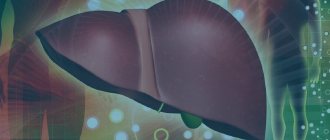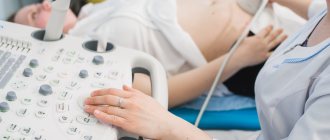Acute coronary syndrome (ACS)
Symptoms of acute coronary syndrome
The main symptom of acute coronary syndrome is pain:
by nature - squeezing or pressing, often there is a feeling of heaviness or lack of air;
localization (location) of pain - behind the sternum or in the precordial region, that is, along the left edge of the sternum; pain radiates to the left arm, left shoulder or both arms, neck area, lower jaw, between the shoulder blades, left subscapular area;
More often, pain occurs after physical activity or psycho-emotional stress;
duration – more than 10 minutes;
after taking nitroglycerin the pain does not go away.
OKS forms
Forms of acute coronary syndrome are distinguished by changes in the electrocardiogram (ECG, a method of recording the electrical activity of the heart on paper) - by changes in the ST segment (a segment of the ECG curve that corresponds to the period of the cardiac cycle when both ventricles are completely covered by excitation).
Acute coronary syndrome with ST segment elevation - it reflects the presence of acute complete occlusion (blockage of the lumen) of the coronary artery.
Acute coronary syndrome without ST segment elevation - in the treatment of patients with this form of the disease, thrombolytics (drugs that destroy a thrombus (blood clot) closing the lumen of the vessel) are not used:
myocardial infarction (death of cells in an area of the heart muscle as a result of disruption of its blood supply);
unstable angina (a variant of acute myocardial ischemia, the severity and duration of which is insufficient for the development of myocardial infarction).
Causes
A sudden disruption of the blood supply to the heart muscle, resulting from a discrepancy between the supply of oxygen to the myocardium and the need for it, is the direct cause of the development of acute coronary syndrome. This happens for the following reasons:
- atherosclerosis of the coronary arteries (feeding the heart muscle) is a chronic disease characterized by hardening and loss of elasticity of the walls of the arteries, narrowing of their lumen due to the so-called atherosclerotic plaques (a formation consisting of a mixture of fats (primarily cholesterol (a fat-like substance that is a “building material”) "for body cells) and calcium) with subsequent disruption of the blood supply to the heart;
- thrombosis (blockage) of the coronary arteries , which occurs when an atherosclerotic plaque breaks off - a formation consisting of a mixture of fats, primarily cholesterol (a fat-like substance that is a “building material” for the body’s cells) and calcium, which can be located in any vessel of the body, and transferring it with the bloodstream to the coronary artery.
The main cause of ACS is the formation of an unstable plaque with a high risk of capsular rupture and the formation of a partially or completely occluding thrombus of the coronary artery, which determines the clinical and electrophysiological picture of coronary pathology. A marker of the formation of an unstable atherosclerotic plaque is an increase in the concentration of pro-inflammatory cytokines (C-reactive peptide) in the blood serum.
ACS, according to the clinical course and dynamics of changes on the ECG, is divided into two subtypes: ACS without ST-segment elevation on the ECG (ACS-BPST) and ACS with ST-segment elevation on the ECG (ACS-PST).
NSTE-ACS - patients with chest pain, but without ST-segment elevation on the ECG.
ACS-PST - patients with typical pain or other unpleasant sensations (discomfort) in the chest, persistent ST-segment elevation, or new-onset left bundle branch block (LBBB).
Patients with suspected ACS, and especially acute MI, should be hospitalized in specialized hospitals to identify the diagnosis, decide on treatment tactics (conservative medication, artificial thrombolysis, mechanical recanalization, endovascular angioplasty, surgery), to monitor the rhythm of cardiac activity and indicators of central hemodynamics.
Factors to the occurrence of acute coronary syndrome include:
- heredity (heart disease is often found in close relatives);
- high level of cholesterol in the blood - a large amount of low-density lipoprotein (a combination of fat and protein) (LDL), or “bad” cholesterol (a combination of fat and protein) low-density lipoprotein (LDL), accumulates in the body, while the level of high-density lipoprotein (HDL), the “good” high-density lipoprotein (HDL) cholesterol, decreases;
- tobacco abuse (smoking tobacco in any form (cigarettes, cigars, pipes), chewing tobacco);
- obesity;
- high blood pressure (arterial hypertension);
- diabetes (a disease associated with an absolute or relative deficiency of insulin, a pancreatic hormone);
- lack of regular physical activity, sedentary lifestyle;
- excessive consumption of fatty foods;
- frequent psycho-emotional stress;
- male gender (men get sick more often than women);
- old age (the risk of getting sick increases with age, especially after 40 years).
Diagnostics
Recognition of ACS is based on three groups of criteria. The first group consists of signs determined during questioning and physical examination of the patient, the second group - data from instrumental studies, and the third - results of laboratory tests.
Typical clinical manifestations of ACS are anginal pain at rest lasting more than 20 minutes, new-onset angina of functional class III, progressive angina. Atypical manifestations of ACS include varied pain in the chest that occurs at rest, epigastric pain, acute digestive disorders, pain characteristic of pleural damage, and increasing shortness of breath. Physical examination of patients with ACS often does not reveal any abnormalities. Its results are important not so much for the diagnosis of ACS, but for detecting signs of possible complications of myocardial ischemia, identifying heart diseases of a non-ischemic nature and determining extracardiac causes of the patient’s complaints.
The main method of instrumental diagnosis of ACS is electrocardiography. The ECG of a patient with suspected ACS should, if possible, be compared with data from previous studies. In the presence of appropriate symptoms, NS is characterized by ST segment depression of at least 1 mm in two or more adjacent leads, as well as T wave inversion with a depth of more than 1 mm in leads with a predominant R wave. Developing MI with a Q wave is characterized by persistent ST segment elevation , for Prinzmetal's angina and developing MI without a Q wave - transient ST segment elevation. In addition to the usual resting ECG, Holter monitoring of the electrocardiosignal is used to diagnose ACS and monitor the effectiveness of treatment.
Of the biochemical tests used to diagnose ACS, the determination of the levels of cardiac troponins T and I in the blood is considered preferable, an increase in which is the most reliable criterion of myocardial necrosis. A less specific, but more accessible criterion for determination in clinical practice is an increase in the blood level of creatine phosphokinase (CPK) due to its isoenzyme MB-CPK. An increase in the content of MB-CPK (preferably mass rather than activity) in the blood by more than twice as compared to the upper limit of normal values in the presence of characteristic complaints, ECG changes and the absence of other causes of hyperenzymemia allows one to confidently diagnose MI.
Brief recommendations for providing medical care to patients with acute coronary syndrome
The Recommendations outline the basic principles of medical care and the algorithm of actions of a doctor and paramedic in patients with acute coronary syndrome. In each specific case, if necessary, correction is possible depending on the characteristics of the course of the disease.
The recommendations are intended for physicians and paramedics working in medical organizations providing primary health care* and emergency physicians/paramedics.
The term "acute coronary syndrome" is used to refer to an exacerbation of coronary heart disease. This term combines clinical conditions such as myocardial infarction (MI) (all forms) and unstable angina. There are ACS with ST segment elevation and without ST segment elevation.
Acute coronary syndrome with ST segment elevation is diagnosed in patients with an anginal attack or other unpleasant sensations (discomfort) in the chest and ST segment elevation or new or suspected new left bundle branch block on the ECG. In this case, persistent ST segment elevation is maintained for at least 20 minutes. ST-segment elevation myocardial infarction is characterized by the occurrence of ST elevation in at least two consecutive leads, which is assessed at the level of the J point and is 0.2 mV in men or ³0.15 mV in women in leads V2-V3 and/or 0.1 mV in other leads (in cases where there is no left bundle branch block and left ventricular hypertrophy).
Acute coronary syndrome without ST segment elevation is diagnosed in patients with an anginal attack and ECG changes indicating acute myocardial ischemia, but without ST segment elevation, or with ST segment elevation lasting less than 20 minutes. These patients may experience persistent or transient ST depression, inversion, flattening or pseudo-normalization of T waves. In some cases, the ECG may be normal.
Symptoms. A typical manifestation of ACS is the development of an anginal attack. The nature of the pain is varied: squeezing, pressing, burning. The most typical is a feeling of tightness or pressure behind the sternum. Pain may radiate to the left arm and/or shoulder, throat, lower jaw, epigastrium, etc. Sometimes patients complain of atypical pain only in the radiating area, for example, in the left arm. With myocardial infarction, the pain can be wave-like and last from 20 minutes to several hours.
The pain syndrome is often accompanied by a feeling of fear (“fear of death”), agitation, anxiety, as well as autonomic disorders, for example, increased sweating.
PRINCIPLES OF TREATMENT OF ANGINOUS ATTACK
with normal or elevated blood pressure and without signs of left ventricular failure
- The patient should immediately stop all exertion and, if possible, lie down.
- Give the patient nitroglycerin 0.5 mg sublingually.
- After 5 minutes, re-administer nitroglycerin 0.5 mg sublingually.
- If chest pain or discomfort persists 5 minutes after re-administration of nitroglycerin, immediately call an ambulance and re-give nitroglycerin 0.5 mg or isosorbide dinitrate spray 1.25 mg sublingually.
- Take an ECG (performed simultaneously with 2-4 points).
- In the presence of an emergency physician, an intravenous infusion of nitroglycerin 1% 2 - 4 ml or isosorbide dinitrate 0.1% 2 - 4 ml in 200 ml of physiological solution begins intravenously, the initial infusion rate is 15 - 20 mcg / min (5 - 7 drops per minute), the maximum rate of drug administration is 250 mcg/min. Criterion for the adequacy of the infusion rate: reduction in systolic blood pressure by 10 - 15 mm Hg. Art. and/or relief of anginal status.
- If the therapy is ineffective, morphine hydrochloride or sulfate 1% - 1.0 ml (10 mg), diluted in at least 10 ml of 0.9% sodium chloride solution or distilled water, is administered intravenously. Initially, 2-4 mg of this drug should be administered intravenously slowly. If necessary, the administration is repeated every 5-15 minutes at 2-4 mg until pain is relieved or side effects occur that do not allow increasing the dose.
- If the blood pressure level remains > 180/10 mm. Hg Art. – establish intravenous drip administration of nitroglycerin at a rate of 10-200 mcg/hour, depending on the blood pressure level.
- ! If acute coronary syndrome is suspected, the patient should immediately be prescribed Acetylsalicylic acid (in the absence of absolute contraindications - hypersensitivity to the drug, active bleeding) at a dose of 250 mg, chewed sublingually!!!
- At the same time, prescribe Clopidogrel at a loading dose of 300 mg.
Mandatory 12-lead ECG recording:
- In case of suspected ACS, during the first 10 minutes of contact with the patient
- In the case of a normal ECG and an increasing clinical picture, the ECG recording is repeated after 30 minutes and after 1 hour.
What can be seen on an ECG:
- normal ECG
- various rhythm disturbances
- left bundle branch block
- tall positive T waves
- negative T waves
- ST depression
- ST depression and negative T waves
- ST depression and positive peaked T waves
- high R and ST elevation.
PRINCIPLES OF TREATMENT OF ANGINOUS ATTACK
against the background of arterial hypotension (systolic blood pressure < 90 mm Hg)
- Call an ambulance immediately
- The patient should immediately stop all exertion and take a horizontal position
- Take an ECG
The drug of choice for stopping an anginal attack is intravenous administration of morphine hydrochloride or sulfate 1% -1.0 ml (10 mg), diluted in at least 10 ml of 0.9% sodium chloride solution or distilled water. Initially, 2–4 mg of the drug should be administered intravenously slowly. If necessary, the administration is repeated every 5-15 minutes at 2-4 mg until pain is relieved or side effects occur that do not allow increasing the dose.
In the absence of morphine, it is necessary to use any available parenteral analgesics, for example, analgin 3 - 4 ml 50%.
! If acute coronary syndrome is suspected, the patient should be immediately prescribed Acetylsalicylic acid (in the absence of absolute contraindications - hypersensitivity to the drug, active bleeding) at a dose of 250 mg, sublingually, chewed!!!
! At the same time, prescribe Clopidogrel at a loading dose of 300 mg.
PRINCIPLES OF TREATMENT OF ANGINOUS ATTACK,
occurring with acute left ventricular failure
against the background of normal or elevated blood pressure
- Call an ambulance immediately
- The patient should immediately stop all exertion and take a semi-sitting position.
- Take an ECG
- The drug of choice for stopping an anginal attack is intravenous administration of morphine hydrochloride or sulfate 1% - 1.0 ml (10 mg) diluted in at least 10 ml of 0.9% sodium chloride solution or distilled water. Initially, 2–4 mg of the drug should be administered intravenously slowly. If necessary, the administration is repeated every 5 - 15 minutes, 2 - 4 mg until pain is relieved or side effects occur that do not allow increasing the dose.
- Give the patient nitroglycerin 0.5 mg sublingually.
- Intravenous infusion of nitroglycerin 1% 2 - 4 ml or isosorbide dinitrate 0.1% 2 - 4 ml in 200 ml of physiological solution intravenously, initial infusion rate 15 - 20 mcg/min (5 - 7 drops per minute), maximum rate of drug administration 250 mcg/min. Criterion for the adequacy of the infusion rate: a decrease in systolic blood pressure by 10 - 15 mm. Hg Art. and/or relief of anginal status.
- ! If acute coronary syndrome is suspected, the patient should be immediately prescribed Acetylsalicylic acid (in the absence of absolute contraindications - hypersensitivity to the drug, active bleeding) at a dose of 250 mg, sublingually, chewed!!!
- ! At the same time, prescribe Clopidogrel at a loading dose of 300 mg.
TREATMENT OF ANGINOUS ATTACK occurring with acute left ventricular failure against the background of arterial hypotension (systolic blood pressure < 90 mm Hg. Art.)
- Call an ambulance immediately
- Take a 12-lead ECG
- The drug of choice for relieving an anginal attack is morphine 1% - 0.5 ml, diluted in at least 10 ml of 0.9% sodium chloride solution or distilled water. Initially, 2-4 mg of the drug should be administered intravenously slowly. If necessary, the administration is repeated every 5-15 minutes at 2-4 mg until pain is relieved or side effects occur that do not allow increasing the dose.
- For low blood pressure (systolic blood pressure < 90 mmHg), provide intravenous dopamine 200 mg in 200 ml of saline (initial rate 3 mcg/min/kg, if there is no effect, the infusion rate increases by 3 mcg/min/kg, maximum speed is 12 µg/min/kg). If hypotension persists and there are clinical signs of relative hypovolemia - the absence of moist rales in the lungs and swelling of the neck veins - it is advisable to administer 200-250 ml of 0.9% sodium chloride solution over 5-10 minutes. If arterial hypotension persists, repeated administration of a 0.9% sodium chloride solution is possible up to a total volume of 0.5-1.0 l. If shortness of breath or moist rales in the lungs occurs, the fluid infusion should be stopped.
- ! If acute coronary syndrome is suspected, the patient should be immediately prescribed Acetylsalicylic acid (in the absence of absolute contraindications - hypersensitivity to the drug, active bleeding) at a dose of 250 mg, sublingually, chewed!!!
- ! At the same time, prescribe Clopidogrel at a loading dose of 300 mg.
Recommendations for reperfusion therapy in patients with acute coronary syndrome
Within 30 minutes from the first contact with a patient with acute coronary syndrome, the emergency medical team, along with pain relief and hemodynamic stabilization (maintaining blood pressure at the proper level), must decide on reperfusion therapy - thrombolysis or percutaneous coronary intervention (PCI) for this patient:
- If it is possible and certain that PCI (emergency stenting of the coronary artery that caused the development of ACS) will be performed within 2 hours, the patient is immediately hospitalized at the nearest medical facility, where high-tech interventions are performed on the infarction-related coronary artery.
- If PCI is not possible within this time frame, thrombolytic therapy (TLT) is required, which is carried out by an emergency medical team. TLT is indicated in the first 12 hours after the onset of pain and ECG criteria for ACS with ST segment elevation.
ECG criteria for initiating reperfusion therapy are persistent ST segment elevations ≥0.1 mV in at least two adjacent ECG leads (≥ 0.25 mV in men under 40 years old/0.2 mV in men over 40 years old and ≥0.15 mV in women in leads V2-V3) in the absence of left ventricular hypertrophy or (presumably) acute left bundle branch block (especially with concordant ST segment elevations in leads with a positive QRS complex). If there is ST segment depression ≥0.05 mV in leads V1-V3, especially with positive T waves, it is recommended to record an ECG in leads V7-V9 (detecting ST elevations ≥0.05 mV/≥0.01 mV in men under 40 years of age is the basis for reperfusion treatment).
* According to the Order of the Ministry of Health of the Russian Federation dated May 15, 2012 No. 543n, primary pre-medical health care is provided by paramedics of medical and obstetric stations, medical outpatient clinics, health centers, clinics, and outpatient departments of medical organizations. Primary medical care is provided by general practitioners, local physicians, general practitioners (family doctors) of outpatient clinics, health centers, clinics, outpatient departments of medical organizations, offices of general practitioners (family doctors). Primary specialized health care in the “cardiology” profile is provided by cardiologists of polyclinics and outpatient departments of medical organizations.
The recommendations were prepared by the staff of the Russian Cardiology Research and Production Complex of the Ministry of Health of Russia, Professor S.N. Tereshchenko, Professor M.Ya. Ruda, Professor I.I. Staroverov.








